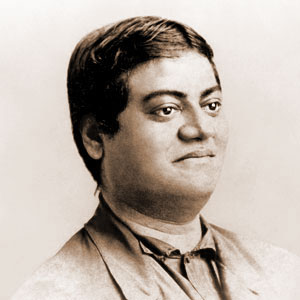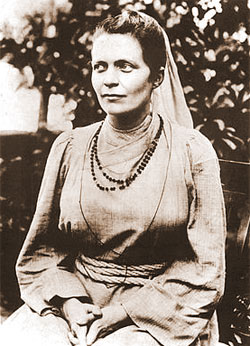The Need of a Women’s Monastic Organization according to Swami Vivekananda
 Swami Vivekananda Once Swami Vivekananda told his guru, Sri Ramakrishna, that he only wanted to be immersed in the state of nirvikalpa samadhi. His guru told him that he was surprised at his ‘mean-mindedness’ as there was a state in spiritual life higher than self-realization or liberation. He expected his disciple to see God in humanity and work for the welfare of all beings. To fulfill this aim, Vivekananda wanted to build an organization. He wrote to his brother disciples, ‘Perfect sincerity, holiness, gigantic intellect, and an all-conquering will. Let only a handful of men work with these and the whole world will be revolutionized. ...It is the patient up-building of character, the intense struggle to realize the truth, which alone will tell in the future of humanity. ...Come! Apply yourselves heart and soul to it. ... We want two thousand sannyasins, nay ten, or even twenty thousand men and women, both.’
Swami Vivekananda Once Swami Vivekananda told his guru, Sri Ramakrishna, that he only wanted to be immersed in the state of nirvikalpa samadhi. His guru told him that he was surprised at his ‘mean-mindedness’ as there was a state in spiritual life higher than self-realization or liberation. He expected his disciple to see God in humanity and work for the welfare of all beings. To fulfill this aim, Vivekananda wanted to build an organization. He wrote to his brother disciples, ‘Perfect sincerity, holiness, gigantic intellect, and an all-conquering will. Let only a handful of men work with these and the whole world will be revolutionized. ...It is the patient up-building of character, the intense struggle to realize the truth, which alone will tell in the future of humanity. ...Come! Apply yourselves heart and soul to it. ... We want two thousand sannyasins, nay ten, or even twenty thousand men and women, both.’
Swami Vivekananda’s brother monks could not at first comprehend the spiritual power of Holy Mother Sri Sarada Devi till Swamiji pointed it out to them. He wrote to them, ‘You have not yet understood the wonderful significance of Mother’s life — none of you. ...Without Shakti, there is no regeneration for the world’. Vivekananda, with the support of scriptural authority, desired to demonstrate the Vedantic truth that there is no distinction of sex in the realm of spirituality. One and the same consciousness is present in all beings. Swamiji strongly supported the cause of women desiring to pursue the spiritual path leading to illumination and liberation.
Swami Vivekananda went to America in 1893 to raise funds for his country. What Swami Vivekananda faced in America was hardship as much as victory and fame. After becoming famous overnight at the World’s Fair in Chicago, he lectured at least twice a day from city to city, town to town. He was only able to sleep on the trains, during these journeys. He faced ridicule for his foreign dress and he faced the bitterly cold winter of North Eastern States with insufficient clothing - a penniless monk, struggling alone with one purpose only: to raise funds for a women’s Math, for Mother and Mother’s daughters. Holy Mother Sri Sarada Devi was to be the inspiration of this Math and it was to be on the Eastern bank of the Ganga.
 Margaret Noble, later known as Sister NiveditaIn 1896, in London, Lady Isabel Margesson invited Vivekananda to her home. One of her friends was Miss Margaret Elizabeth Noble, who was the principal of a School in Wimbledon. She was also a member of the Sesame Club and was deeply interested in educational work. After hearing a few lectures by Swami Vivekananda, Margaret accepted him as her guru. Margaret immediately responded to Swamiji’s invitation when, during a conversation, he turned to her and said, “I have plans for the women of my own country in which you, I think, could be of great help to me.” Margaret Noble, later known as Sister Nivedita, one of the best interpreters of Vivekananda’s ideas, reached India on the 28th January, 1898.
Margaret Noble, later known as Sister NiveditaIn 1896, in London, Lady Isabel Margesson invited Vivekananda to her home. One of her friends was Miss Margaret Elizabeth Noble, who was the principal of a School in Wimbledon. She was also a member of the Sesame Club and was deeply interested in educational work. After hearing a few lectures by Swami Vivekananda, Margaret accepted him as her guru. Margaret immediately responded to Swamiji’s invitation when, during a conversation, he turned to her and said, “I have plans for the women of my own country in which you, I think, could be of great help to me.” Margaret Noble, later known as Sister Nivedita, one of the best interpreters of Vivekananda’s ideas, reached India on the 28th January, 1898.
On the 25th March of the same year, Vivekananda accepted her in the fold of the Ramakrishna Order when he initiated her into Brahmacharya, the vows of a novice nun and gave her the name Nivedita, the Dedicated One. Nivedita conducted an educational institution in Kolkata for training women to become able pilgrims, on the path of worldly excellence and spiritual realization.
Once, in a country boat, on the Ganga, near the Belur Math ghat, Swamiji pointed to Nivedita, in the direction of Dakshineswar, and said that he had begun to take steps for a home for Mother and her daughters. Holy Mother Sri Sarada Devi was to be the inspiration for this Math and it was to be on the Eastern bank of the Ganga.
